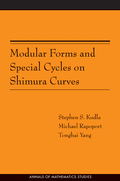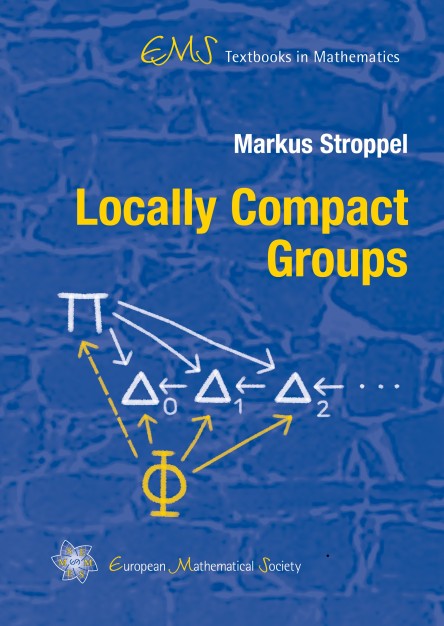Stephen S. Kudla, Michael Rapoport, and Tonghai Yang
Modular Forms and Special Cycles on Shimura Curves
 Paper | 2006 | ISBN: 0-691-12551-1
Paper | 2006 | ISBN: 0-691-12551-1
Cloth | 2006 | ISBN: 0-691-12550-3
384 pp. | 6 x 9 | 1 line illus. 3 tables.
Annals of Mathematics Studies, vol.161.
Modular Forms and Special Cycles on Shimura Curves is a thorough
study of the generating functions constructed from special
cycles, both divisors and zero-cycles, on the arithmetic surface
"M" attached to a Shimura curve "M" over the
field of rational numbers. These generating functions are shown
to be the q-expansions of modular forms and Siegel modular forms
of genus two respectively, valued in the Gillet-Soule arithmetic
Chow groups of "M". The two types of generating
functions are related via an arithmetic inner product formula. In
addition, an analogue of the classical Siegel-Weil formula
identifies the generating function for zero-cycles as the central
derivative of a Siegel Eisenstein series. As an application, an
arithmetic analogue of the Shimura-Waldspurger correspondence is
constructed, carrying holomorphic cusp forms of weight 3/2 to
classes in the Mordell-Weil group of "M". In certain
cases, the nonvanishing of this correspondence is related to the
central derivative of the standard L-function for a modular form
of weight 2. These results depend on a novel mixture of modular
forms and arithmetic geometry and should provide a paradigm for
further investigations. The proofs involve a wide range of
techniques, including arithmetic intersection theory, the
arithmetic adjunction formula, representation densities of
quadratic forms, deformation theory of p-divisible groups, p-adic
uniformization, the Weil representation, the local and global
theta correspondence, and the doubling integral representation of
L-functions.
Stephen S. Kudla is at the University of Maryland. Michael
Rapoport is at the Mathematisches Institut der Universitat, Bonn,
Germany. Tonghai Yang is at the University of Wisconsin, Madison.
Table of Contents:
Acknowledgments ix
Chapter 1. Introduction 1
Bibliography 21
Chapter 2. Arithmetic intersection theory on stacks 27
Chapter 3. Cycles on Shimura curves 45
Chapter 4. An arithmetic theta function 71
Chapter 5. The central derivative of a genus two Eisenstein
series 105
Chapter 6. The generating function for 0-cycles 167
Chapter 6 Appendix. The case p = 2, p | D (B) 181
Chapter 7. An inner product formula 205
Chapter 8. On the doubling integral 265
Chapter 9. Central derivatives of L-functions 351
Index 371
Paul J. Nahin
Dr. Euler's Fabulous Formula:
Cures Many Mathematical Ills
Cloth | 2006 | ISBN: 0-691-11822-1
404 pp. | 6 x 9 | 2 halftones.77 line illus.
In the mid-eighteenth century, Swiss-born mathematician Leonhard
Euler developed a formula so innovative and complex that it
continues to inspire research, discussion, and even the
occasional limerick. Dr. Euler's Fabulous Formula shares the
fascinating story of this groundbreaking formula--long regarded
as the gold standard for mathematical beauty--and shows why it
still lies at the heart of complex number theory.
This book is the sequel to Paul Nahin's An Imaginary Tale: The
Story of I [the square root of -1], which chronicled the events
leading up to the discovery of one of mathematics' most elusive
numbers, the square root of minus one. Unlike the earlier book,
which devoted a significant amount of space to the historical
development of complex numbers, Dr. Euler begins with discussions
of many sophisticated applications of complex numbers in pure and
applied mathematics, and to electronic technology. The topics
covered span a huge range, from a never-before-told tale of an
encounter between the famous mathematician G. H. Hardy and the
physicist Arthur Schuster, to a discussion of the theoretical
basis for single-sideband AM radio, to the design of chase-and-escape
problems.
The book is accessible to any reader with the equivalent of the
first two years of college mathematics (calculus and differential
equations), and it promises to inspire new applications for years
to come. Or as Nahin writes in the book's preface: To
mathematicians ten thousand years hence, "Euler's formula
will still be beautiful and stunning and untarnished by time."
Paul J. Nahin is Professor Emeritus of Electrical Engineering at
the University of New Hampshire. He is the author of Duelling
Idiots and Other Probability Puzzlers, When Least Is Best: How
Mathematicians Discovered Many Clever Ways to Make Things as
Small (or as Large) as Possible, and An Imaginary Tale: The Story
of I [the square root of -1] (all Princeton).
Endorsements:
"If you ever wondered about the beauties and powers of
mathematics, this book is a treasure trove. Paul Nahin uses
Euler's formula as the magic key to unlock a wealth of surprising
consequences, ranging from number theory to electronics,
presented clearly, carefully, and with verve."--Peter Pesic,
St. John's College
"The range and variety of topics covered here is impressive.
I found many little gems that I have never seen before in books
of this type. Moreover, the writing is lively and enthusiastic
and the book is highly readable."--Des Higham, University of
Strathclyde, Glasgow
Seydel, Rudiger U.
Tools for Computational Finance, 3rd ed.
 Series: Universitext
Series: Universitext
2006, XIX, 304 p. 75 illus., Softcover
ISBN: 3-540-27923-7
About this textbook
This book is very easy to read and one can gain a quick snapshot
of computational issues arising in financial mathematics.
Researchers or students of the mathematical sciences with an
interest in finance will find this book a very helpful and gentle
guide to the world of financial engineering. SIAM review (46,
2004).
The third edition is thoroughly revised and significantly
extended. The largest addition is a new section on analytic
methods with main focus on interpolation approach and quadratic
approximation. New sections and subsections are among others
devoted to risk-neutrality, early-exercise curves,
multidimensional Black-Scholes models, the integral
representation of options and the derivation of the Black-Scholes
equation.
New figures, more exercises, more background material make this
guide to the world of financial engineering a real must-to-have
for everyone working in FE.
Table of contents
Modelling Tools for Financial Options.- Generating Random Numbers
with Specified Distributions.- Simulation with Stochastic
Differential Equations.- Standard Methods for Standard Options.-
Finite-Element Methods.- Pricing of Exotic Options.- Appendices
Markus Stroppel (University of Stuttgart, Germany):
Locally Compact Groups
 EMS Textbooks in Mathematics
EMS Textbooks in Mathematics
ISBN 3-03719-016-7
February 2006, 312 pages, hardcover, 16.5 cm x 23.5 cm.
Locally compact groups play an important role in many areas of
mathematics as well as in physics. The class of locally compact
groups admits a strong structure theory, which allows to reduce
many problems to groups constructed in various ways from the
additive group of real numbers, the classical linear groups and
from finite groups. The book gives a systematic and detailed
introduction to the highlights of that theory.
In the beginning, a review of fundamental tools from topology and
the elementary theory of topological groups and transformation
groups is presented. Completions, Haar integral, applications to
linear representations culminating in the Peter-Weyl Theorem are
treated. Pontryagin duality for locally compact Abelian groups
forms a central topic of the book. Applications are given,
including results about the structure of locally compact Abelian
groups, and a structure theory for locally compact rings leading
to the classification of locally compact fields. Topological
semigroups are discussed in a separate chapter, with special
attention to their relations to groups. The last chapter reviews
results related to Hilbert's Fifth Problem, with the focus on
structural results for non-Abelian connected locally compact
groups that can be derived using approximation by Lie groups.
The book is self-contained and is addressed to advanced
undergraduate or graduate students in mathematics or physics. It
can be used for one-semester courses on topological groups, on
locally compact Abelian groups, or on topological algebra.
Suggestions on course design are given in the preface. Each
chapter is accompanied by a set of exercises that have been
tested in classes.
Table of contents
 Paper | 2006 | ISBN: 0-691-12551-1
Paper | 2006 | ISBN: 0-691-12551-1 Series: Universitext
Series: Universitext  EMS Textbooks in Mathematics
EMS Textbooks in Mathematics